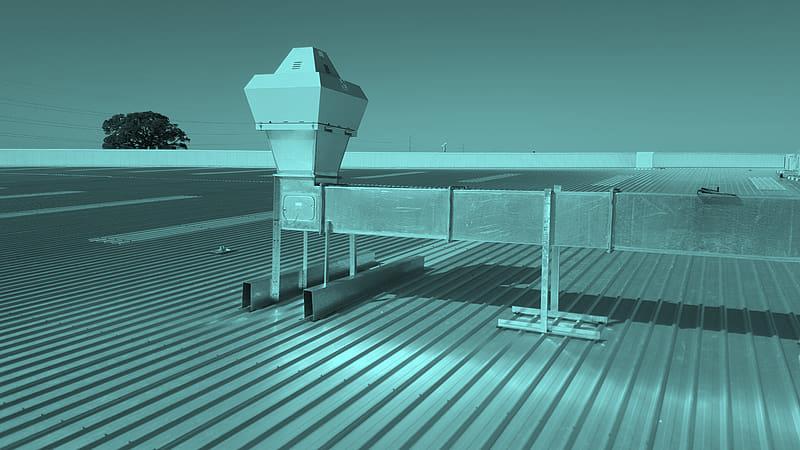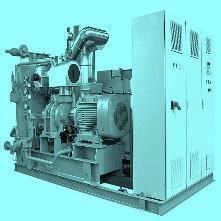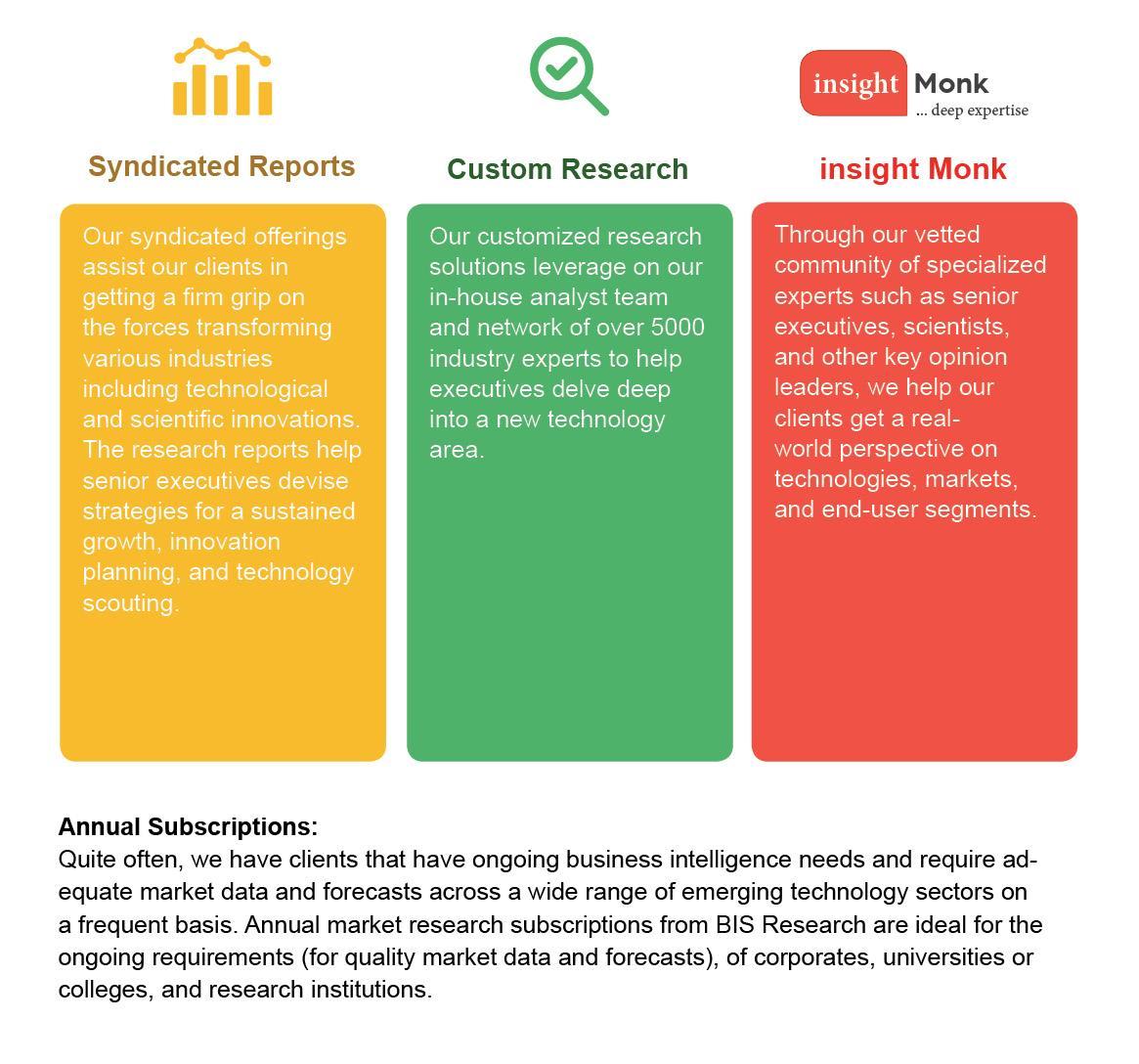





BIS Research is a leading market intelligence and technology research company. BIS Research publishes in depth market intelligence reports focusing on the market estimations, technology analysis, emerging high growth applications, deeply segmented granular country level market data and other important market parameters useful in the strategic decision making for senior management. BIS Research provides multi client reports, company profiles, databases, and custom research services.

Copyright © 2020 BIS Research
All Rights Reserved. This document contains highly confidential information and is the sole property of BIS Research. Disclosing, copying, circulating, quoting or otherwise reproducing any or all contents of this document is strictly prohibited. Access to this information is provided exclusively for the benefit of the people or organization concerned. It may not be accessed by, or offered whether for sale or otherwise to any third party.
All rights reserved at BIS Research
Preface
The energy management industry has witnessed a massive transformation over the past five years, owing to the increasing demand for HVAC systems in commercial, residential and industrial sector Earlier, the industry was driven by resources, however it is now driven majorly by technology and innovation. Rising population and energydemand, along with the increase in greenhouse gasemission, has resulted in the growing concerns to enhance energy efficiency and energy conservation.
With the rapid implementation of energy management systems, the commercial, industrial, and residential end users are able to conserve energy with the help of functions of energy management system such as heating, ventilation, and air conditioning (HVAC) and lighting systems. The demand for HVAC products across the ANZ region are expected to remain high from commercial, residential, and industrial sector.
The demand for HVAC products in ANZ is majorly driven by the increasing population, and the increasing number of residential and commercial projects in the region. Several initiatives undertaken by the local government, and emerging trend of green/smart buildings are forcing HVAC manufacturers and suppliers to launch energy efficient and technologically advanced HVAC units for commercial, residential, institutional and industrial sectors. Many leading global companies dealing with HVAC products are expanding their business across Australia and New Zealand, by increasing their distribution outlets across the region and launching products which are specifically designed as per the local environment.
The market research study offers a wide perspective on the Australia and New Zealand market and analyses its impact on the end users by providing critical insights into the direction of its future expansion. The research is based on extensive primary interviews (in house experts, industry leaders, and market players) and secondary research (a host of paid and unpaid databases), along with the analytical tools that have been used to build the forecast and the predictive models.

The study has been designed to answer some of the most crucial questions about the Australia and New Zealand market:
▪
What is the ANZ HVAC market size in terms of value and volume, and what is the expected growth rate during the forecast period 2019 2024?
▪
What is the expected growth and market size for ANZ HVAC market based on different types of HVAC systems?
▪
What are the major driving forces that are expected to increase the demand for the ANZ HVAC market during the forecast period?
▪
What is the market size (value and volume) of windows and portable air conditioners across Australia and New Zealand?
▪
What is the market size (value and volume) of mini split air conditioners across Australia and New Zealand?
▪
What is the market size (value and volume) of single packaged air conditioners across Australia and New Zealand?
▪
▪
What is the market size (value and volume) of chillers across Australia and New Zealand?
What is the market size (value and volume) of air handling units across Australia and New Zealand?

▪
What is the market size (value and volume) of fan coil unit across Australia and New Zealand?
▪
What is the market size (value) of different types of fan coil unit across Australia and New Zealand?
▪
What is the market size (value) of fan coil unit, by end user segments across Australia and New Zealand?
▪
What are the key trends and opportunities in the market pertaining to ANZ HVAC industry?
▪
▪
What are the major challenges inhibiting the growth of the ANZ HVAC market?
What is the competitive strength of the key players in the ANZ HVAC market on the basis of analysis of their recent developments, product offerings, and regional presence?
The reportisa compilation of ANZHVACmarket segmented majorlybytype into windowsand portable, minisplit, single packaged, chillers, airhandling unit, and fan coilunit. In the extensive primary research process undertaken for this study, the primary sources further include industry experts and key executives from prominent companies and organizations in the ANZ HVAC market.
BIS Energy & Sustainability March 2020
rights reserved at BIS Research





List of Tables
Table 1: Significant Construction Projects across Australia and New Zealand 19
Table 2: Market Snapshot: ANZ HVAC Market, by Volume 21
Table 1.1: Impact Analysis of Drivers 26
Table 1.2: Improvements Implemented Under EEOB Program, Australia............................................ 28
Table 1.3: Supply Chain Structure, HVAC Systems, Australia & New Zealand ................................... 29
Table 1.4: Impact Analysis of Restraints ................................................................................................ 31
Table 1.5: Green Infrastructure Pipeline, 2020, Australia...................................................................... 34
Table 1.6: Technologies with Opportunities in HVAC............................................................................ 36
Table 2.1: Analyzing Threat of New Entrants......................................................................................... 45
Table 2.2: Analyzing Bargaining Power of Buyers................................................................................. 46
Table 2.3: Analyzing Bargaining Power of Suppliers............................................................................. 48
Table 2.4: Analyzing the Threat from Substitutes .................................................................................. 49
Table 2.5: Analyzing the Intensity of Competitive Rivalry...................................................................... 50
Table 3.1: Australia Window & Portable AC Market, $Million, 2016-2024............................................ 56
Table 3.2: Australia Window & Portable AC Market, Thousand Units, 2016-2024............................... 56
Table 3.3: Australia Mini Split Air Conditioners Market, by Type, $Million, 2016-2024 ....................... 58
Table 3.4: Australia Mini Split Air Conditioners Market, by Type, Thousand Units, 2016 2024 59
Table 3.5: Australia Ductless Systems Market, by Capacity, $Million, 2016 2024 59
Table 3.6: Australia Ductless Systems Market, by Capacity, Thousand Units, 2016 2024 60
Table 3.7: Australia Ductless Systems Market, by Ductless Type, $Million, 2016 2024 60

Table 3.8: Australia Ductless Systems Market, by Ductless Type, Thousand Units, 2016 2024 61
Table 3.9: Australia Ducted Systems Market, by Capacity, $Million, 2016 2024 61
Table 3.10: Australia Ducted Systems Market, by Capacity, Thousand Units, 2016 2024 62
Table 3.11: Australia Ducted Systems Market, by Type, $Million, 2016 2024 62
Table 3.12: Australia Ducted Systems Market, by Type, Thousand Units, 2016 2024 63
Table 3.13: Advantages and Disadvantages of Packaged Air Conditioners 63
Table 3.14: Australia Chillers Market, by Type, $Million, 2016 2024 66
Table 3.15: Australia Chillers Market, by Type, Thousand Units, 2016 2024....................................... 66
Table 3.16: Australia Chillers Market, by Cooling Type, $Million, 2016 2024....................................... 67
Table 3.17: Australia Chillers Market, by Cooling Type, Thousand Units, 2016 2024 67
Table 3.18: Australia Chillers Market, by Capacity, $Million, 2016 2024 68
Table 3.19: Australia Chillers Market, by Capacity, Thousand Units, 2016 2024 68
Table 3.20: Benefits of Fan Coil Units 71
Table 3.21: Australia FCU Market, by Type, $Million, 2016 2024......................................................... 72
Table 3.22: Australia FCU Market, by Type, Thousand Units, 2016 2024 ........................................... 73
Table 3.23: Australia FCU Market, by Application, $Million, 2016 2024............................................... 73
Table 3.24: Australia FCU Market, by Application, Thousand Units, 2016-2024.................................. 74
Table 4.1: Difference between Windows AC and Portable AC.............................................................. 79
Table 4.2: New Zealand Window & Portable AC Market, $Million, 2016-2024..................................... 80
Table 4.3: New Zealand Window & Portable AC Market, Thousand Units, 2016-2024...................... 81
Table 4.4: New Zealand Mini Split Air Conditioners Market, by Type, $Million, 2016 2024 84
Table 4.5: New Zealand Mini Split Air Conditioners Market, by Type, Thousand Units, 2016 2024 84
Table 4.6: New Zealand Ductless Systems Market, by Capacity, $Million, 2016 2024 85
Table 4.7: New Zealand Ductless Systems Market, by Capacity, Thousand Units, 2016 2024 85
Table 4.8: New Zealand Ductless Systems Market, by Ductless Type, $Million, 2016 2024 86

Table 4.9: New Zealand Ductless Systems Market, by Ductless Type, Thousand Units, 2016-2024. 86
Table 4.10: New Zealand Ducted Systems Market, by Capacity, $Million, 2016 2024 87
Table 4.11: New Zealand Ductless Systems Market, by Capacity, Thousand Units, 2016 2024 87
Table 4.12: New Zealand Ducted Systems Market, by Ducted Type, $Million, 2016 2024 88
Table 4.13: New Zealand Ducted Systems Market, by Type, Thousand Units, 2016 2024 88
Table 4.14: Key Companies in New Zealand Providing Single Packaged Air Conditioners 90
Table 4.15: Key Companies in New Zealand Providing Chillers 92
Table 4.16: New Zealand Chillers Market, by Type, $Million, 2016 2024 93
Table 4.17: New Zealand Chillers Market, by Type, Thousand Units, 2016 2024 94
Table 4.18: New Zealand Chillers Market, by Cooling Type, $Million, 2016 2024 94
Table 4.19: New Zealand Chillers Market, by Cooling Type, Thousand Units, 2016 2024 95
Table 4.20: New Zealand Chillers Market, by Capacity, $Million, 2016 2024 95
Table 4.21: New Zealand Chillers Market, by Capacity, Thousand Units, 2016 2024........................ 96
Table 4.22: Key Companies in New Zealand Providing AHU................................................................ 96
Table 4.23: Key Companies in New Zealand Providing FCU................................................................ 99
Table 4.24: New Zealand FCU Market, by Type, $Million, 2016-2024 ...............................................101
Table 4.25: New Zealand FCU Market, by Type, Thousand Units, 2016-2024..................................102
Table 4.26: New Zealand FCU Market, by Application, $Million, 2016-2024......................................102
Table 4.27: New Zealand FCU Market, by Application, Thousand Units, 2016 2024.......................103
Table 5.1: Recent Developments (2017 2019) 106
Table 5.2: Daikin Industries Ltd.: Product Portfolio 110
Table 5.3: FUJITSU: Product Portfolio .................................................................................................115
Table 5.4: Ingersoll Rand: Product Portfolio.........................................................................................119
Table 5.5: Johnson Controls: Product Portfolio....................................................................................125
Table 5.6: LG Electronics: Product Portfolio.........................................................................................131
Table 5.7: Mitsubishi Electric Corporation: Product Portfolio...............................................................136
Table 5.8: Panasonic Corporation: Product Portfolio...........................................................................141
Table 5.9: SAMSUNG: Product Portfolio..............................................................................................146
Table 5.10: Temperzone Group: Product Portfolio 153
Table 5.11: Toshiba Carrier Corporation: Product Portfolio 158
Table 5.12: Toshiba Carrier Corporation: Recent Developments 160
Table 5.13: United Technologies Corporation: Product Portfolio 163
rights reserved at BIS Research

List of Figures
Figure 1: Increasing Population across Australia and New Zealand 2016 2018 18
Figure 2: ANZ HVAC Market Snapshot, by Value, $Million, 2018, 2019 and 2024 20
Figure 3: Australia HVAC Market Share (%, by Type), 2019 and 2024 22
Figure 4: New Zealand HVAC Market Share (%, by Type), 2019 and 2024 ........................................ 23
Figure 1.1: Market Dynamics.................................................................................................................. 25
Figure 1.2: Mid tier Building Profile, Australia ........................................................................................ 27
Figure 1.3: Energy Consumption of an Office Building in Australia....................................................... 31
Figure 1.4: Energy Consumption, by HVAC System Component......................................................... 32
Figure 1.5: Indirect GHG Emissions, by Major Class............................................................................. 32
Figure 1.6: Number of Projects, Green Infrastructure, by Category, Australia, 2020 ........................... 35
Figure 2.1: Strategies Adopted by the Key Players (January 2017-February 2020)............................ 37
Figure 2.2: Share of Key Market Strategies and Developments (January 2017 February 2020)........ 38
Figure 2.3: Product Launches and Developments Share (by Company).............................................. 39
Figure 2.4: Mergers and Acquisitions Share (by Company).................................................................. 40
Figure 2.5: Business Expansion and Contracts Share (by Company).................................................. 41
Figure 2.6: Partnerships, Collaborations, and Joint Ventures Share (by Company)........................... 42

Figure 2.7: Porter’s Five Forces Analysis for the ANZ HVAC Market 44
Figure 2.8: Australia & New Zealand HVAC Market, Distribution Channel Analysis 51
Figure 3.1: Australia HVAC Market, by Product Type 53
Figure 3.2: Australia HVAC Market, by Product Type, $Million, 2019 and 2024 53
Figure 3.3: Australia HVAC Market, by Product Type, Thousand Units, 2019 and 2024 54
Figure 3.4: Australia Window & Portable AC Market, by Value, 2019 55
Figure 3.5: Australia Mini Split Systems, by Value, 2019 57
Figure 3.6: Australia Mini Split Systems, by Volume, 2019 58
Figure 3.7: Australia Single Packaged Air Conditioners Market, $Million, 2016 2024 64
Figure 3.8: Australia Single Packaged Air Conditioners Market, Thousand Units, 2016 2024 65
Figure 3.9: Australia AHU Market, by Value, 2016 2024 69
Figure 3.10: Australia AHU Market, by Volume, 2016 2024.................................................................. 70
Figure 3.11: Australia FCU Market, by Value, 2016 2024..................................................................... 71
Figure 3.12: Australia FCU Market, by Volume, 2016 2024 72
Figure 4.1: New Zealand HVAC Market (by Product Type) 77
Figure 4.2: New Zealand HVAC Market, by Product Type, $Million, 2019 and 2024 77
Figure 4.3: New Zealand HVAC Market, by Product Type, Thousand Units, 2019 and 2024 78
Figure 4.4: New Zealand Windows and Portable AC Market, by Value, 2019 ..................................... 80
Figure 4.5: Advantages and Disadvantages of Multi Split Air Conditioners.......................................... 82
Figure 4.6: Type of Multi Split Air Conditioners...................................................................................... 82
Figure 4.7: New Zealand Mini Split Systems (by Type) by Value, 2019 ............................................... 83
Figure 4.8: New Zealand Mini Split Systems (by Type), by Volume, 2019........................................... 83
Figure 4.9: New Zealand Single Packaged Air Conditioners Market, by Value, 2016-2024................ 90
Figure 4.10: New Zealand Single Packaged Air Conditioners Market, by Value, 2016-2024.............. 91

Figure 4.11: New Zealand AHU Market, by Value, 2016 2024 98
Figure 4.12: New Zealand AHU Market, by Volume, 2016 2024 98
Figure 4.13: New Zealand FCU Market, by Value, 2016 2024 100
Figure 4.14: New Zealand FCU Market, by Volume, 2016 2024 101
Figure 5.1: Actron Engineering Pty Ltd.: Product Category 107
Figure 5.2: Actron Engineering Pty Ltd.: SWOT Analysis....................................................................108
Figure 5.3: Daikin Industries Ltd.: Overall Financials, 2017 2019 111
Figure 5.4: Daikin Industries Ltd.: Net Revenue by Regional Segment, 2017 2019 111
Figure 5.5: Daikin Industries Ltd.: Net Revenue by Business Segment, 2016 2018 112
Figure 5.6: Daikin Industries: SWOT Analysis 113
Figure 5.7: FUJITSU: Overall Financials, 2016 2018 115
Figure 5.8: FUJITSU: Net Revenue by Operating Segment 2016 2018 116
Figure 5.9: FUJITSU: Net Revenue by Regional Segment 2016 2018 116
Figure 5.10: FUJITSU: SWOT Analysis 117
Figure 5.11: Ingersoll Rand: Overall Financials, 2016 2018 120
Figure 5.12: Ingersoll Rand: Net Revenue by Business Segment, 2016 2018 121
Figure 5.13: Ingersoll Rand: Net Revenue by Regional Segment, 2016 2017 121
Figure 5.14: Ingersoll Rand: Net Revenue by Regional Segment, 2018............................................122
Figure 5.15: Ingersoll Rand: SWOT Analysis.......................................................................................123
Figure 5.16: Johnson Controls: Overall Financials, 2017 2019...........................................................127
Figure 5.17: Johnson Control: Net Revenue by Business Segment, 2017-2019...............................128
Figure 5.18: Johnson Controls: Net Revenue by Regional Segment, 2017-2019.............................128
Figure 5.19: Johnson Controls: SWOT Analysis..................................................................................129
Figure 5.20: LG Electronics: Overall Financials, 2017 2019 ...............................................................132
Figure 5.21: LG Electronics: Net Revenue by Business Segment, 2017 2019 133
Figure 5.22: LG Electronics: SWOT Analysis 134
Figure 5.23: Mitsubishi Electric Corporation: Overall Financials, 2017 2019......................................137
Figure 5.24: Mitsubishi Electric Corporation: Net Revenue (by Region), 2017 2019........................137
Figure 5.25: Mitsubishi Electric Corporation: Net Revenue (by Business Segment), 2017 2019......138
Figure 5.26: Mitsubishi Electric Corporation: SWOT Analysis.............................................................139
Figure 5.27: Panasonic Corporation: Overall Financials, 2017-2019..................................................142
Figure 5.28: Panasonic Corporation: Net Revenue (by Region), 2017-2019.....................................142
Figure 5.29: Panasonic Corporation: Net Revenue (by Business Segment), 2017-2019..................143
Figure 5.30: Panasonic Corporation: SWOT Analysis 144
Figure 5.31: SAMSUNG: Product Portfolio 148
Figure 5.32: SAMSUNG: Overall Financials, 2017 2019 148
Figure 5.33: SAMSUNG: Net Revenue by Business Segment, 2017 2019 149
Figure 5.34: SAMSUNG: Net Revenue by Regional Segment, 2017 2019 150
Figure 5.35: SAMSUNG: SWOT Analysis............................................................................................151
Figure 5.36: Temperzone Group: SWOT Analysis 156
Figure 5.37: Toshiba Carrier Corporation: SWOT Analysis 161
Figure 5.38: United Technologies Corporation: Overall Financials, 2016 2018 164
Figure 5.39: United Technologies Corporation: Net Revenue by Business Segment, 2016 2018 165
Figure 5.40: United Technologies Corporation: Net Revenue by Regional Segment, 2016 2018 165
Figure 5.41: United Technologies Corporation: SWOT Analysis 166
Figure 6.1: ANZ HVAC Market Scope 171
Figure 6.2: Report Methodology 172
Figure 6.3: Primary Interviews Breakdown (by Company, Designation, and Country) 174
Figure 6.4: Sources of Secondary Research 175
Figure 6.5: Data Triangulation 176
Figure 6.6: Top Down Bottom Up Approach for Market Estimation....................................................177
All rights reserved at BIS Research



